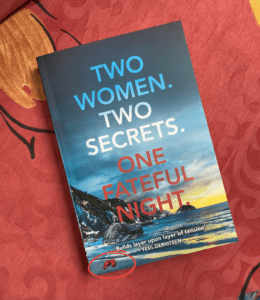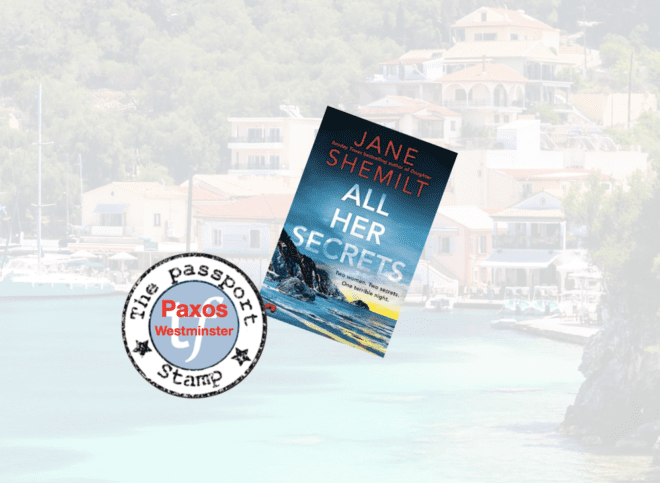When a book cover does the author no favours
Novel set mainly on Paxos (and London)
18th August 2023
All Her Secrets by Jane Shemilt, novel set mainly on Paxos.
This is a dual timeline novel set in both 2003 and 2023 and the author manages the dovetailing of the two periods very well.
In 2003 we are introduced to an English family who takes regular holidays on Paxos. The Greek family next door oversees the running of their house and looks after the guests when they are in residence; Sophie is the daughter, a 13 year old girl who helps out by serving and running errands. She cannot swim but heads out first thing to enjoy the sea – before the guests get up – often with Nico, her younger brother, in tow. On one occasion she is interrupted by two male teenagers from the house, who attempt to help to her learn to swim. The connection to Jay and Ginger is now established.
In 2023 Julia is living in the shadow of Big Ben with her husband, James, an unpleasant man who loves to control all aspects of her life. For her it is a trade-off: she gets to cook in her husband’s school, a public school in Westminster (rather thinly disguised), and materially she enjoys some reasonably pleasant living arrangements for herself and her daughter, with whom she came into the marriage. She is a kind woman who also helps out at a charity and there she meets Razul, a refugee, whom she takes under her wing and gradually encourages his talented cooking skills, Psychologically she has no doubt clearly hooked up with James because of her abusive experience from her father, history repeats. She turns to an Italian therapist, who happens to make herself known to both James and Julia at a works event at the school.
In 2003 young Sophie endures a life shattering event, whilst the British guests are in the property in Paxos, and she is reticent to share what happened with her family – given the shame that would culturally be involved. The family understands the nature of her experience and flees their house.
Julia, it transpires, had a connection to the family at the property in 2003, she was briefly there, but knew nothing of what went on in Sophie’s life, although their paths briefly crossed.
Throughout the novel there is quite a good sense of setting, both for Paxos and London (also Corfu and Cornwall).
Part of the premise of this story is based on the fact Sophie had stolen some nail varnish from one of the British guests and applied it to her toenails. One evening she is accosted by the two aforementioned British boys, who have been drinking and they immediately recognise her act of theft. It feels absurd and extremely unlikely that boys of that age (any age?) would be able to identify a specific nail varnish colour, but more significantly the rods and cones in human eyes cannot detect colour when the light is dim, so they wouldn’t have been able to actually see any colour on Sophie’s toe nails. The story then moves on to a pivotal scene where a phone camera is used, in the dim light, and evidence contained in the resulting photographs moves the story along. Again, this is unlikely. In 2003 the phone camera was available but the camera quality was still very poor. Photos at that point would have had such poor resolution, it would have been hard to see an image taken in the relative dark (check out this article on The Complete History of the Camera Phone). And around that time, didn’t you have to pop the card into the computer to be able to see the images? Anyway, whatever…
Razul then goes on to play a pivotal part in the narrative, which just had my eyes rolling. Husband James makes a life changing decision within a period of two weeks, which again seemed unbelievable and just felt like a device to move the book towards the concluding chapters.
 The basic question here is: where was the editor who could have styled this novel – which has a lot of talent, creativity and potential – into a book that was more firmly rooted in the real world, and who could have encouraged a more streamlined trajectory? Given, also, the cover of this novel does not represent the setting (When a Book Cover misrepresents setting), I feel the publisher (and it is one of the big publishing houses) has really let this author down and produced a novel that could have been so much more, simply with a bit more effort and experienced input. As Tess Gerritesen says on the cover, the novel “Builds layer upon layer of tension” but to my mind just not in a very convincing way.
The basic question here is: where was the editor who could have styled this novel – which has a lot of talent, creativity and potential – into a book that was more firmly rooted in the real world, and who could have encouraged a more streamlined trajectory? Given, also, the cover of this novel does not represent the setting (When a Book Cover misrepresents setting), I feel the publisher (and it is one of the big publishing houses) has really let this author down and produced a novel that could have been so much more, simply with a bit more effort and experienced input. As Tess Gerritesen says on the cover, the novel “Builds layer upon layer of tension” but to my mind just not in a very convincing way.
Tina for the TripFiction Team
Join team TripFiction on Social Media:
Twitter (@TripFiction), Facebook (@TripFiction.Literarywanderlust), YouTube (TripFiction #Literarywanderlust), Instagram (@TripFiction) and Pinterest (@TripFiction)


 Please wait...
Please wait...

I suppose the question is also, how much input should the editor have, versus how much research should an author undertake, to ensure the accuracy of the information and the authenticity of the storyline, in their novel?
Surely anyone can bang a novel out if you are not doing any fact checking or extensive research about your subject, along the way?
Just posing the question… 🙂